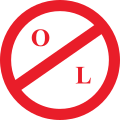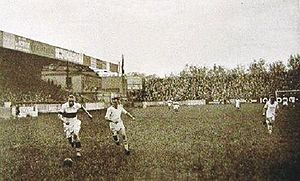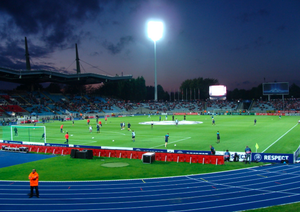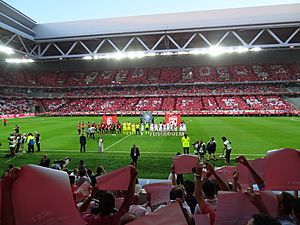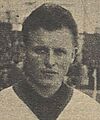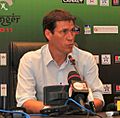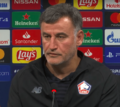Lille OSC facts for kids
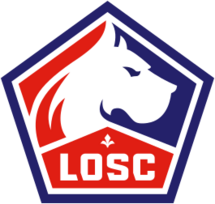 |
|||
| Full name | Lille Olympique Sporting Club | ||
|---|---|---|---|
| Nickname(s) | Les Dogues (The Mastiffs) Les Nordistes (The Northmen) Les Lillois (The Lillois) La Machine de Guerre (The War Machine) |
||
| Short name |
|
||
| Founded | 23 September 1944 | ||
| Stadium | Stade Pierre-Mauroy | ||
| Stadium capacity |
50,186 | ||
| Owner | Merlyn Partners SCSp | ||
| President | Olivier Létang | ||
| Head coach | Bruno Génésio | ||
| League | Ligue 1 | ||
| 2021–22 | Ligue 1, 10th of 20 | ||
|
|
|||
Lille Olympique Sporting Club, often called LOSC or simply Lille, is a French professional football club. It is based in Lille, a city in Northern France. The team plays in Ligue 1, which is the top football league in France. Since 2012, Lille has played its home games at the Stade Pierre-Mauroy. This stadium can hold 50,186 fans and has a roof that can open or close. It is the fourth-largest stadium in France.
Lille was formed in 1944 when two older clubs, Olympique Lillois and SC Fives, joined together. Both of these clubs were among the first teams in the French Division 1. Olympique Lillois even won the first league title in 1932–33. The club's most successful time was from 1946 to 1956, right after World War II. During this period, they won seven major trophies, including winning both the league and the cup in 1946. They were known as La Machine de Guerre, which means "The War Machine" in French.
Lille won another league and cup double in 2011. They also won their fourth league title in 2021 and their first Trophée des Champions (a super cup) in the same year. This makes Lille the fourth-best French club in the 21st century.
In France, the club has won four league titles, six Coupes de France (French Cup), and one Trophée des Champions. In European competitions, Lille has played in the UEFA Champions League nine times. They have reached the knockout stages three times. They have also played in the UEFA Europa League nine times and reached the quarter-finals of the UEFA Conference League once. In 2004, they won the UEFA Intertoto Cup. Lille is one of the few clubs in the top division that has finished in the top three of the French championship at least 15 times.
The team's nickname is Les Dogues, meaning "The Mastiffs" in French. Lille is famous for its youth academy, which has helped many talented young players become professionals. The club is also known for finding and developing young players. According to the CIES Football Observatory, Lille is the best club in the world for making money from selling non-academy players since 2015. Lille has a long-standing rivalry with nearby club Lens, called the Derby du Nord. Lille has won more games against Lens and has more trophies overall. The club is led by Olivier Létang and is one of the most popular French sports clubs on social media.
Club History
The War Machine: Early Success (1944–1955)
Before Second World War, Lille had two top football clubs: Olympique Lillois and SC Fives. Olympique Lillois won the first French Division 1 title in 1932–33. They also reached the Coupe de France final in 1939. SC Fives finished second in the league in 1933–34 and reached the Coupe de France final in 1941.
Because of the war, both clubs were weakened. So, on September 23, 1944, they decided to merge. This created Stade Lillois, which was renamed Lille Olympique Sporting Club a few weeks later. The new club was officially registered on November 25, 1944.
In its first season, the new club reached the 1945 Coupe de France final. The next season, Lille won both the league and the cup in 1946. They beat Red Star in the cup final and finished first in the league. In 1947, Lille won the Coupe de France again, beating Strasbourg. They won the cup for a third time in a row in 1948, defeating their rivals Lens. They also finished second in the league in 1948, 1949, 1950, and 1951.
On May 31, 1953, Lille won their fourth Coupe de France trophy, beating FC Nancy 2–1. The club then won its second league title in 1953–54. They only let in 22 goals in 34 games that season, showing how strong their defense was. A year later, Les Dogues won their fifth Coupe de France, beating Bordeaux 5–2 in the final. This successful time after the war earned them the nickname La Machine de Guerre ("The War Machine"). In its first ten years, the club won most of its major trophies. They won two league titles and finished second four times in a row. Lille was known as the best French club after the war.
Tough Times and Rebuilding (1955–2000)
The 1955–56 season was very difficult for Lille. The club had problems inside, and some players refused to play. The team's defense was weak, and they finished 16th. In 1956, Lille was relegated (moved down) from the top division for the first time. This also caused big financial problems. The best players had to leave to pay off debts.
Because of money issues, the club kept moving between the first and second divisions. In 1969, Lille even gave up its professional status because it lacked facilities and money. After a few years in amateur leagues, Lille became a professional team again in 1970. They won the second division that season.
During the 1970s, the club continued to have financial problems. The city of Lille had to help the club many times. In 1978, Lille finally returned to the top division of French football. They stayed there until 1997. In 1980, Lille became the first French club to be a "mixed economy company." This meant the city of Lille owned most of the club, which helped make it financially stable.
However, Lille struggled to compete with the top teams and usually finished in the middle of the league table. In 1991, they finished sixth, close to qualifying for European competitions. In 1994, Bernard Lecomte became president and saved the club from more financial trouble. During this time, Lille focused on developing young players from its youth academy. But another money crisis led to the club being relegated to the second division in 1997.
While in Division 2, the club was bought by new owners in 1999. With coach Vahid Halilhodžić, Lille quickly found success again. They dominated the 1999–2000 Division 2 season, winning the championship by a large margin. This earned them promotion back to the top league.
Back to the Top and New Double (2000–2017)
In their first season back in the top league (2000–01), Lille qualified for European competitions for the first time. They earned a spot in the 2001–02 UEFA Champions League. With new leadership and coach Claude Puel, Lille moved from their old stadium to the Stadium Lille Métropole. They became a regular team in European football. They had big wins, like beating Manchester United 1–0 in 2005 and Milan 2–0 in 2006.
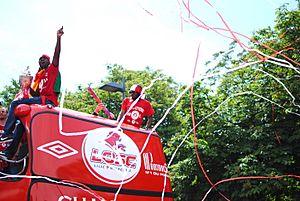
In the 2010s, Lille grew stronger both on and off the field. They became one of the most important clubs in French Ligue 1. In 2007, they opened a large, modern training complex called Domaine de Luchin. Also, the Grand Stade Lille Métropole (later renamed Stade Pierre-Mauroy) was built. It opened in 2012 and is the fourth-largest football stadium in France.
Under coach Rudi Garcia, Lille returned to the top of the French league. Fifty-six years after their last trophy, the 2010–11 team won the club's second double. Players like Yohan Cabaye, Mathieu Debuchy, and Eden Hazard helped them finish first in the league. They also beat Paris Saint-Germain in the 2011 Coupe de France final.
In the 2011–12 and 2012–13 seasons, Lille continued to be a top French team. They finished third and sixth, qualifying for the Champions League again. In 2013, Garcia left, and René Girard became the new manager. Under Girard, Lille finished third in 2013–14. After two years, Girard left the club.
In May 2015, Hervé Renard became the new manager, but he was replaced by Frederic Antonetti in November 2015. A year later, Antonetti's contract was ended as the team was near the bottom of the league.
Campos and Galtier Era: Success (2017–2021)
In early 2017, Lille hired Luís Campos to lead their player recruitment. Soon after, famous Argentine manager Marcelo Bielsa joined the club. However, Bielsa was suspended in November 2017 after an unauthorized trip. The team was again near the bottom of the league. On December 23, 2017, Bielsa was replaced by Christophe Galtier. In a tough 2017–18 season, Lille managed to avoid being relegated to Ligue 2.
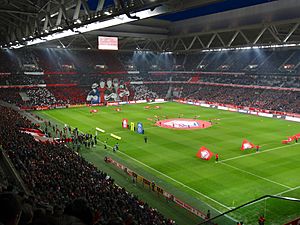
Lille's next season was very different. With new players like José Fonte, Loïc Rémy, Zeki Çelik, Jonathan Bamba, Jonathan Ikoné, and Rafael Leão, the team started winning many games. They lost only five games in the first half of the 2018–19 Ligue 1 season. On April 14, 2019, in front of a record crowd of 49,712 fans, Lille beat Paris Saint-Germain 5–1 at home. Goals came from Nicolas Pépé, Jonathan Bamba, Gabriel, and captain José Fonte. At the end of the season, Lille finished second, qualifying for the 2019–20 UEFA Champions League. This was their first time back in the competition in seven years.
On August 1, 2019, Lille sold their top scorer, Nicolas Pépé, to Arsenal for a club-record fee of €80 million. On the same day, Lille signed Victor Osimhen and Tiago Djaló. They also brought in Timothy Weah, Reinildo Mandava, Benjamin André, Yusuf Yazıcı, and Renato Sanches. In early March 2020, Lille was in 4th place. However, the 2019–20 Ligue 1 season ended early because of the COVID-19 pandemic.
In the summer of 2020, Lille signed young talents like Sven Botman and Jonathan David, as well as experienced player Burak Yılmaz. By the end of the first half of the 2020–21 season, Lille had lost only two games. They were at the top of the league, having beaten rivals Lens 4–0 in October 2020. Lille started the second half of the season with six wins in a row. On April 3, 2021, Lille won at Paris with a goal from Jonathan David, taking first place in the league. Three weeks later, Lille came back from two goals down to beat Lyon 3–2. Burak Yılmaz scored twice, including a great free kick.
On May 23, Lille won the Ligue 1 title with a 2–1 victory at Angers. This was their fourth Ligue 1 title, achieved under manager Christophe Galtier. Goalkeeper Mike Maignan had 21 clean sheets that season, almost a league record. Lille also played in the 2020–21 UEFA Europa League. They beat AC Milan 3–0 in November 2020, with Yusuf Yazıcı scoring three goals. However, they lost to Ajax in the round of 32.
Recent Seasons and European Growth (2021–Present)
In the 2021–22 season, Lille won its first Trophée des Champions. They beat Paris Saint-Germain 1–0 in Israel on August 1, 2021. The team then reached the UEFA Champions League round of 16, where they were defeated by Chelsea. They had qualified from a group with Salzburg, Sevilla, and Wolfsburg. A report at the end of the 2021–22 Ligue 1 season showed that Lille is the fourth-best French club in Ligue 1 in the 21st century.
On June 29, 2022, Paulo Fonseca was appointed as the new head coach. The 2022–23 season started well, with a 4–1 home win against Auxerre on August 7. On October 9, they beat rivals Lens 1–0 at home. Fonseca's Lille team is known for its stylish, attacking football. They often play in a 4–2–3–1 formation, with players like Benjamin André, André Gomes, or Angel Gomes in midfield. As of July 2025, Bruno Génésio is the head coach.
Club Identity
Crest and Nicknames
Lille's club crest has changed many times over the years. The first crest used by the new club was the shield of the city of Lille, which dates back to 1235. It showed a white fleur-de-lys on a red background. The fleur-de-lys is a symbol that refers to the city's name and its history. The colors white and red represent wisdom, wealth, passion, and faithfulness.
White and red were the colors of Olympique Lillois. Blue, which is often used for the team's shorts, comes from SC Fives. Red is still the main color used by the club today.
In 1981, the mastiff dog appeared on the club crest for the first time. It has been there ever since. The nickname Les Dogues ("The Mastiffs") shows the team's strong and determined playing style. This nickname was first used for Olympique Lillois players in the 1920s. Other common nicknames for the club are Les Nordistes ("The Northmen") and Les Lillois (people from Lille).
New crests were introduced in 1989, 1997, 2002, and 2012. Each one featured the mastiff and the fleur-de-lys in different ways. The latest crest, revealed in 2018, includes all the club's symbols: the initials "LOSC", the mastiff, the fleur-de-lys, and the three colors. It is shaped like a regular pentagon, which is the shape of the heart of the Citadel of Lille.
- Lille OSC crest history
Team Kits and Sponsors
Lille OSC's first home kit was white and blue. The white jersey had a large red "V" shape around the neck and red sleeve ends. This design was inspired by Olympique Lillois. The "V" shape and the blue shorts and socks came from SC Fives. White was the main color of the jersey, with small touches of red. The red "V" was on every jersey until 1964. After that, the jersey became plain white with only red collars and sleeve ends for many years.
In the 1990s, different kit makers added various red designs. In 1999, Lille changed its main kit color to red. Away jerseys became mostly white. For the 2016–17 season, the club wore a white home kit again. This was to celebrate 70 years since they won the league and cup double in 1946.
Third kits are usually worn for European games. In the early 2000s, they were blue. Later, they started using the colors of the flag of Flanders: black and yellow. Since the 2000s, the club has released many black or yellow third kits.
Lille has had many different kit suppliers. The first was Le Coq Sportif from 1970 to 1975. In the 1980s, Puma was a well-known supplier for nine years. After that, brands like Lotto and Adidas supplied the kits. Reebok was the supplier for three seasons, followed by Nike in 1999. Other suppliers included Kipsta (a brand from the Lille region), Airness, and Canterbury. Nike returned in 2013 for three years.
On June 22, 2016, Lille announced a five-year deal with New Balance. This made them one of the biggest football teams to sign with the Boston-based sportswear company. This partnership was renewed in 2021 until June 2026.
The first main sponsors of the club were Jean Caby butchery and Pel d'Or lemonade. One of Lille's most famous sponsors was Peaudouce, a French company that made nappies. Their logo was on the club's shirt for over ten years. Other well-known sponsors include Eurest, Crédit Agricole, and ING Direct. The "P" logo of the French casino company Partouche appeared on Lille's jersey in 2003. Partouche is Lille's most loyal sponsor, having been on the shirt for fourteen seasons. Recent main sponsors include French electronics retailer Boulanger and British online car retailer Cazoo.
Club Grounds
Stadiums
After Lille OSC was formed, the team played its home games at the stadiums of the two merged clubs: Stade Henri-Jooris (from Olympique Lillois) and Stade Jules-Lemaire (from SC Fives). In 1949, the club decided to use Stade Henri-Jooris as its main home ground. Stade Jules-Lemaire was later used for training and was demolished in 1959. Stade Henri-Jooris, named after a famous president of Olympique Lillois, could hold 15,000 fans. It was Lille's home until 1975.
In 1975, Lille moved to Stade Grimonprez-Jooris. This stadium was located near the old one. It originally held 25,000 people, but this was reduced to about 17,000 by 2000 due to safety rules. In 2000, the stadium was updated, and its capacity increased to 21,000. However, it still did not meet modern football standards. So, in 2002, plans were made to build a new stadium.
In 2003, the club agreed to build a new 33,000-seat stadium on the site of Stade Grimonprez-Jooris. But this project faced opposition from people who wanted to protect the historical area. They successfully stopped the building permits.
In May 2004, Stade Grimonprez-Jooris closed. Because of the delays, Lille had to play its league matches at Stadium Nord Lille Métropole, which held 18,000 fans. They played their 2005–06 Champions League games at Stade de France near Paris. After two years of legal battles, the new Grimonprez-Jooris stadium was canceled. The old Grimonprez-Jooris was demolished in 2010. Lille stayed at Stadium Lille Métropole until the end of the 2011–12 season.
On February 1, 2008, a company called Eiffage was chosen to build a new 50,000-seat stadium. This stadium would be multi-purpose, meaning it could host football, basketball, tennis, handball, and concerts. The Stade Pierre-Mauroy opened on August 17, 2012. It was first called the Grand Stade Lille Métropole, but was renamed in 2013 after Pierre Mauroy, a former mayor of Lille and Prime Minister of France. The stadium is in Villeneuve-d'Ascq and can hold 50,186 people. It is France's fourth-largest stadium.
The Stade Pierre-Mauroy has hosted games for the French national football and rugby teams. It also hosted matches for UEFA Euro 2016 and will be one of the venues for the 2023 Rugby World Cup. The stadium's arena part has hosted EuroBasket 2015, Davis Cup matches, and the 2017 World Men's Handball Championship. It will also host handball and basketball for the 2024 Olympic Games. The record attendance for a sports game at the stadium is 49,712 fans, who watched Lille beat Paris Saint-Germain 5–1 in 2019.
Training Facilities
The Domaine de Luchin has been the club's training ground since 2007. It is located in Camphin-en-Pévèle, about 15 minutes from central Lille. This large area has nine full-size pitches, including one artificial turf pitch. It also has a training field for goalkeepers. The club's main offices, the academy facilities, classrooms, and bedrooms are all there. There is also a medical center, a fitness center, and areas for the press.
A famous bronze statue of a mastiff, called "Dogue de Bronze" ("The Bronze Mastiff"), was put there in 2011. The main pitch at the facility can hold 1,000 spectators and hosts matches for the academy and women's teams. In March 2024, Lille OSC renamed this pitch "Terrain Eden Hazard" ("Eden Hazard pitch") after the club legend Eden Hazard. A piece of the Berlin Wall with a graffiti of Hazard on it is also on display at the center.
Club Rivalries
The Derby du Nord ("The North Derby") is a football rivalry between Lille and Lens. This derby is named after their location in northern France. The two cities are only about 30 kilometers apart. The name can also sometimes refer to matches between Lille and Valenciennes, but the main derby is with Lens. The Lille–Valenciennes match is sometimes called Le Petit Derby du Nord ("The Little North Derby").
The two clubs first played each other in 1937. A strong rivalry grew because the clubs are close and their fans have different backgrounds. Lens is known as a working-class, industrial mining city. Lille is seen as a middle-class, modern city. However, today, fans from both clubs come from various backgrounds.
As of 2024, Lille and Lens have played over 115 matches. Lille has won 46 times, Lens has won 37 times, and 36 matches have been draws. Lille has won more top division titles, more Coupe de France trophies, and more Trophée des Champions titles than Lens. Lille has also played more games in top French and European competitions.
Club Honours
Domestic Titles
- French Division 1/Ligue 1
- Winners (4): 1945–46, 1953–54, 2010–11, 2020–21
- Runners-up (6): 1947–48, 1948–49, 1949–50, 1950–51, 2004–05, 2018–19
- French Division 2
- Winners (4): 1963–64, 1973–74, 1977–78, 1999–2000
Cup Titles
- Coupe de France
- Winners (6): 1945–46, 1946–47, 1947–48, 1952–53, 1954–55, 2010–11
- Runners-up (2): 1944–45, 1948–49
- Coupe de la Ligue
- Runners-up (1): 2015–16
- Trophée des Champions
- Winners (1): 2021
- Runners-up (2): 1955, 2011
European Titles
- UEFA Intertoto Cup
- Winners (1): 2004
- Runners-up (1): 2002
- Latin Cup
- Runners-up (1): 1951
Doubles
- French Division 1/Ligue 1 and Coupe de France (2): 1945–46, 2010–11
Images for kids
-
Guillaume Bieganski, a top Lille player in the late 1950s
-
Jonathan David, Lille's current record signing
See also
 In Spanish: Lille Olympique Sporting Club para niños
In Spanish: Lille Olympique Sporting Club para niños


